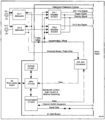11A32
The Tektronix 11A32 is a 400 MHz dual-channel amplifier plug-in for 11000-series scopes and DSA600-series scopes.
Key Specifications
| Bandwidth | DC to 400 MHz; selectable 100 MHz / 20 MHz 4-pole BWL (Bandwidth Limit) filter |
|---|---|
| Rise time | 875 ps in 1 GHz mainframes such as the 11402, 11402A, 11403, 11403A, DSA601A, or DSA602A |
| Deflection | 1 mV to 10 V per division in 1% calibrated steps |
| Input impedance | 50 Ω or 1 MΩ |
| Features |
|
Links
Documents Referencing 11A32
| Document | Class | Title | Authors | Year | Links |
|---|---|---|---|---|---|
| Electronic-Engineering-Aug-Sept-1988-Versatile-Analogue-Chip-John-Addis.pdf | Article | Versatile Analogue Chip for Oscilloscope Plug-ins | John Addis | 1988 | M377 • 11A32 • 11A33 • 11A34 • 11A52 • Cascomp • Overdrive • Thermals • Gilbert multiplier • Pat Quinn • Gary Polhemus • Art Metz |
Internals
Analog
Each input channel has a separate attenuator module, part number 119-2000-0x, containing passive 1 MΩ attenuators, a 50 Ω termination resistor, an AC coupling capacitor, a switch selecting the calibrator or signal input, and an M474 buffer amplifier. In normal operation the calibrator signal to the attenuator is instead connected to ground.
The attenuator module output feeds the + input of the M377 amplifier IC through a (blue) 50 Ω transmission line, one per input channel. The cable lengths set a standard delay per plugin.
The M377's − input is connected to the ACVS (Analog Control Voltage System) output.
The (differential) display outputs of the two amplifiers are hard-wired in parallel and drive the mainframe’s 50 Ω per side input impedance. The same is true of the trigger outputs of the two amplifiers.
The version of the M377 used in the 11A32 has a 100 Ω output impedance per side so that two of them in parallel create a source impedance of 50 Ω per side.
Each M377 amplifier's nominal common-mode output voltage is zero whether enabled or not. When not enabled, each M377 differential output is exactly zero by design. This fact is used during calibration by the plugin’s firmware to determine the mainframe’s imbalance and compensate for it during normal operation.
Each of the two channels has its own AUX output on dedicated pins of the plug-in interface connector:
| signal name | positive pin number | negative pin number |
|---|---|---|
| AUX 1 | B38 | B37 |
| AUX 2 | A36 | A35 |
See also the block diagram below.
Digital
The 11A32 and the 11A34 use exactly the same firmware.
The 11A34 and 11A32 were originally intended to use Intel 8052 microcontrollers. However, during development, the firmware swelled beyond that chip's 8192-byte maximum on-chip ROM size. Doug Haines found an alternate supplier of 8051-compatible chips (OKI Semiconductor) that offered a 16 KByte on-chip ROM, and that's what the plug-ins wound up with. The finished code size is about 14 KB. There are also units with the OKI M85C154 chip that has a piggyback EPROM (see photo below).
The 11A32 also contains a Dallas Semiconductor DS1220Y NVRAM storing last settings, calibration constants, and instrument serial number. The DS1220Y contains a battery with a typical life time of 20-30 years.
There is also an ACVS (Analog Control Voltage System) sample and hold module on a daughter board that generates the analog voltages needed for gain and offset, including error correction under microcontroller firmware control.
The microcontroller also provides the digital signals sent to the M377 amplifier, setting one of its six fixed gains, one of its three bandwidths, turning on or off its selected output, and each output's normal or invert state.
Digital mainframes do waveform manipulation (addition, subtraction, multiplication, etc.). Consequently only one 11A32 output is on at a time. Analog mainframes however allow more than one channel to be on at a time. This allows the plugin channels to be added or subtracted in the plugin.
Pictures
-
-
-
Block diagram
-
11A32 Input Attenuators
-
11A32 Kernel
-
11A32 Analog Control and Signal Amplifiers
-
11A32 Main Interface
-
left side internal
-
right side internal
Parts
Some Parts Used in the 11A32
| Part | Part Number(s) | Class | Description | Used in |
|---|---|---|---|---|
| 148-0086-00 | 148-0086-00 | Discrete component | miniature relay | 11A32 |
| Intel 8051 | Monolithic integrated circuit | 8-bit microcontroller | 11A32 • 11A34 • WFM300 | |
| M377 | 165-2129-03 • 165-2089-06 • 155-2089-05 | Monolithic integrated circuit | amplifier | 11A16 • 11A32 • 11A33 • 11A34 • 11A52 • 2245 • 2245A • 2247 • 2247A • 2252 • TDS410 • TDS420 • TDS460 • TDS520D • TDS540D • TDS580D • TDS680C • TDS684C • TDS714L • TDS724D • TDS754D • TDS784D |
| M474 | Monolithic integrated circuit | amplifier | 11A32 • 11A34 |







